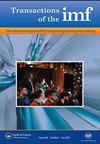无铅锡合金作为镀锡铅合金的替代品
IF 1.5
4区 材料科学
Q4 ELECTROCHEMISTRY
Transactions of The Institute of Metal Finishing
Pub Date : 1997-01-01
DOI:10.1080/00202967.1997.11871162
引用次数: 10
摘要
在许多应用中禁止或限制使用铅和铅元件。因此,目前正在讨论在电子应用的焊料合金中替代铅作为合金元素的可能性。含铅锡合金作为焊料和可焊镀层具有熔点低、有效防止晶须生长、价格低、可用性高等优点。从电化学沉积的角度来看,由于两种元素的标准电位相似,该体系是有利的。因此,不需要络合剂就可以从酸性电解质中沉积任何锡铅比。稳定成熟的工艺可用于技术应用。在寻找无铅焊料时,必须考虑这些因素。电解沉积锡铅的任何替代品都应该可以从对人或环境无害的系统中得到。考虑到上述论点,本文叙述了锡铋合金沉积的初步实验。共晶锡/铋合金已被用作特殊应用的焊料。通过调整电解液中的锡铋比。有可能沉积镀层,其熔点范围与已知的锡/铅合金相似。给出了不同锡铋合金的可焊性、硬度和形貌的初步结果。本文章由计算机程序翻译,如有差异,请以英文原文为准。
Lead-free Tin Alloys as Substitutes for Tin-lead Alloy Plating
The use of lead and lead-components is prohibited or restricted for many applications. Presently there is therefore a discussion on the possibility to substitute lead as an alloying element in solder-alloys for electronic applications. The advantages for lead-containing tin-alloys as solder and solderable coating are for example low melting-point, effective prevention of whisker growth, low price and high availability. From the view of electrochemical deposition, the system is favoured because of the similarity of the standard potentials of both elements. It is therefore possible to deposit from acidic electrolytes without complexing agents any tin-lead ratio. Stable and mature processes are available for technical applications. In the search for lead-free solders these arguments must be considered. The electrolytic deposition of any alternative for tin-lead should be possible from systems which are non-hazardous to people or the environment. Taking account of the above mentioned arguments the paper describes initial experiments on the deposition of tin-bismuth-alloys. The eutectic Sn/Bi-alloy is already used as solder for special applications. By adjusting the Sn/Bi-ratio in the electrolyte. it is possible to deposit coatings, which have a similar range of melting point as known Sn/Pb-alloys. Preliminary results on solderability hardness and topography of different Sn/Bi-alloys are presented.
求助全文
通过发布文献求助,成功后即可免费获取论文全文。
去求助
来源期刊

Transactions of The Institute of Metal Finishing
工程技术-材料科学:膜
CiteScore
3.40
自引率
10.50%
发文量
62
审稿时长
3 months
期刊介绍:
Transactions of the Institute of Metal Finishing provides international peer-reviewed coverage of all aspects of surface finishing and surface engineering, from fundamental research to in-service applications. The coverage is principally concerned with the application of surface engineering and coating technologies to enhance the properties of engineering components and assemblies. These techniques include electroplating and electroless plating and their pre- and post-treatments, thus embracing all cleaning pickling and chemical conversion processes, and also complementary processes such as anodising. Increasingly, other processes are becoming important particularly regarding surface profile, texture, opacity, contact integrity, etc.
 求助内容:
求助内容: 应助结果提醒方式:
应助结果提醒方式:


